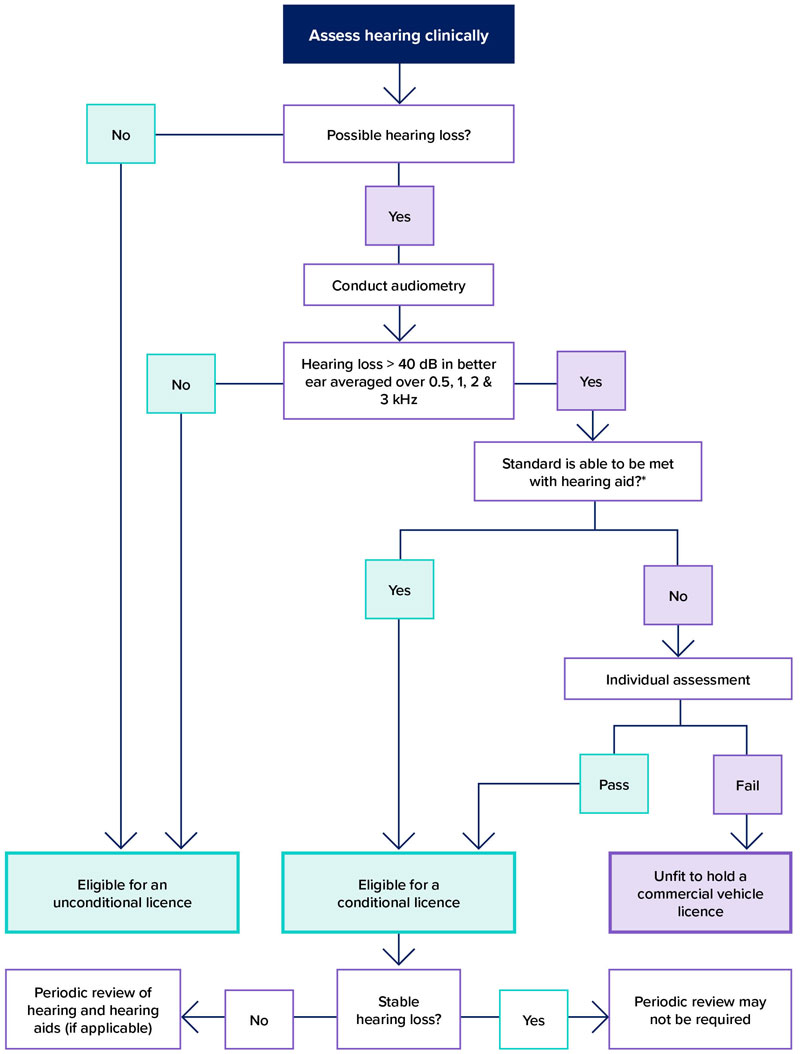4.2 General assessment and management guidelines
4.2.1 Commercial vehicle drivers
Only drivers of commercial vehicles are required to meet a hearing standard for the reasons outlined above. The following hearing assessment applies to all forms of hearing loss including congenital and childhood hearing loss, and hearing loss acquired in later years. The process is summarised in Figure 11. Management of hearing loss in commercial vehicle drivers.
- Compliance with the standard should be clinically assessed initially by the treating doctor, audiologist* or audiometrist**. If there is doubt about the person’s hearing, audiometry should be performed by an ear, nose and throat (ENT) specialist, audiologist* or audiometrist**. The person need not undergo audiometry if their hearing is satisfactory.
- If on audiometry the person has unaided hearing loss greater than or equal to 40 dB in the better ear (averaged over the frequencies 0.5, 1, 2 and 3 KHz), they do not meet the criteria for an unconditional licence.
- If the standard is able to be met with a hearing aid, the driver licensing authority may consider a conditional licence, subject to periodic assessment of hearing, the use of the hearing aid whilst driving and of the hearing aids set at a frequency advised by the ENT specialist, audiologist* or audiometrist**. Stable conditions may not require periodic review.
- If the standard is not able to be met with a hearing aid, this does not disqualify the person from driving. They should be offered individualised assessment to determine their eligibility for a conditional licence. This may comprise assessment by an ENT specialist or audiologist* including consideration of:
- the person’s medical history – for example, childhood deafness may have led to good adaptation
- the person’s driving record before and since the hearing loss
- the nature of the driving task – for example, the type of vehicle (e.g. truck, bus), roads and distances to be travelled
- the ergonomics of the driving cab – for example, assistive devices such as mirrors and a GPS
- concomitant medical conditions such as vision impairment or cognitive impairment
- practical driver assessment if required (refer to Part A section 2.3.1. Practical driver assessments). The report may advise on assistive technologies as a licence condition.
The driver licensing authority may consider a conditional licence based on the information received. Periodic review may include medical review and/or a practical driver assessment at the discretion of the driver licensing authority. The health professional should advise on the frequency of review as determined by the natural history of the condition. Stable conditions may not require periodic review.
In some cases, noise amplification from wearing hearing aids may lead to driver distraction and may warrant individualised assessment as above to determine fitness to drive without the hearing aid.
Figure 11: Management of hearing loss in commercial vehicle drivers

* In some cases noise amplification as a result of wearing hearing aids may lead to driver distraction and may warrant individualised assessment to determine fitness to drive without the hearing aid (refer to section 4.2.1).
4.2.2 Private vehicle drivers
While hearing loss will not preclude driving a private car, people with hearing loss should be advised regarding their loss and their limited ability to hear warning signals. Assistive technologies such as hearing aids, sensors and/ or physical equipment such as additional mirrors might also be used upon consideration of the needs of the individual driver. Occupational therapist driving assessors can assist with identifying vehicle aides.
* For the purposes of this document an audiologist is a person accredited as such by Audiology Australia or the Australian College of Audiology.
** For the purposes of this document, an audiometrist is a person accredited as such by the Australian College of Audiology or the Hearing Aid Audiology Society of Australia .
